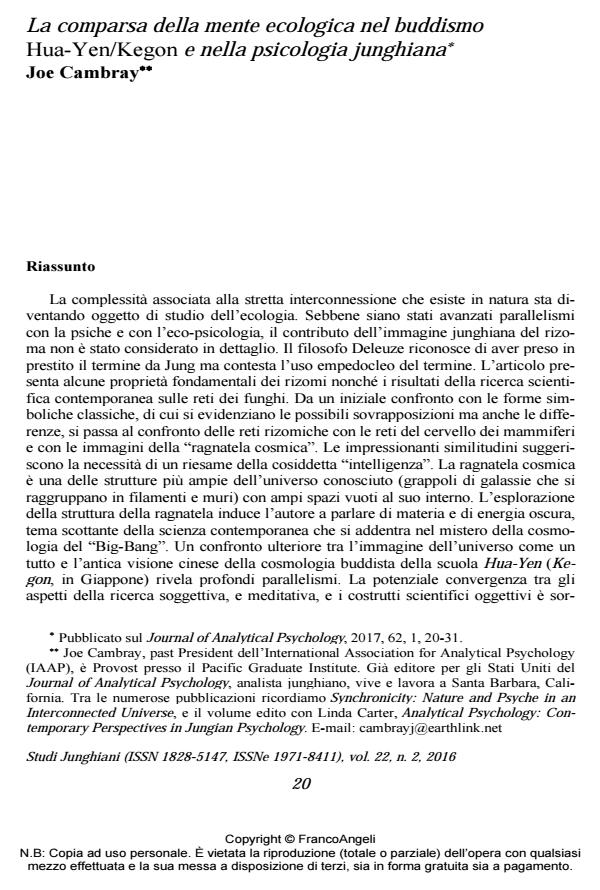The emergence of the ecological mind in Hua-Yen/Kegon Buddhism and Jungian Psychology
Journal title STUDI JUNGHIANI
Author/s Joe Cambray
Publishing Year 2017 Issue 2016/44
Language Italian Pages 10 P. 20-29 File size 169 KB
DOI 10.3280/JUN2016-044003
DOI is like a bar code for intellectual property: to have more infomation
click here
Below, you can see the article first page
If you want to buy this article in PDF format, you can do it, following the instructions to buy download credits

FrancoAngeli is member of Publishers International Linking Association, Inc (PILA), a not-for-profit association which run the CrossRef service enabling links to and from online scholarly content.
The complexity associated with deep interconnectedness in nature is beginning to be articulated and elaborated in the field of ecological studies. While some parallels to the psyche have been made and the field of Eco-psychology has been developing, Jung’s explicit contribution by way of the image of rhizomes has not been considered in detail. Philosopher Gilles Deleuze acknowledges borrowing the term from Jung, though he disagreed with Jung’s Empedoclean use of the term. The paper presents some fundamental properties of rhizomes along with contemporary scientific research on mycorrhizal (fungal) networks. Comparisons are made, first with classical symbolic forms, demonstrating some overlap but also some differences. Then comparison of rhizomal networks is made to those found both in mammalian brains and in recent images of the "cosmic web". While no hard conclusions can be drawn from these images, their remarkable similarities are suggestive of a need to reconsider what is meant by "intelligence". The cosmic web is one of the largest structures in the known universe (clusters of galaxies which form into filaments and walls) with empty spaces in between. Exploration of the structure of this web leads to a discussion of dark matter and dark energy, current hot topics in science, probing into the mysteries of our "Big-Bang" cosmology. An additional comparison of the emerging image of the universe as a whole with the ancient Chinese Buddhist cosmological vision from the Hua-Yen School (Kegon in Japan) again reveals profound parallels. The potential convergence of aspects of subjective, or meditative, explorations with objective scientific constructions is striking and offers links between East and West, as well as potential confirmation of the objective aspects of empathy.
Keywords: Cosmic web, ecological networks, Hua-Yen Buddhism, objective empathy.
Joe Cambray, La comparsa della mente ecologica nel buddismo Hua-Yen/Kegon e nella psicologia junghiana in "STUDI JUNGHIANI" 44/2016, pp 20-29, DOI: 10.3280/JUN2016-044003